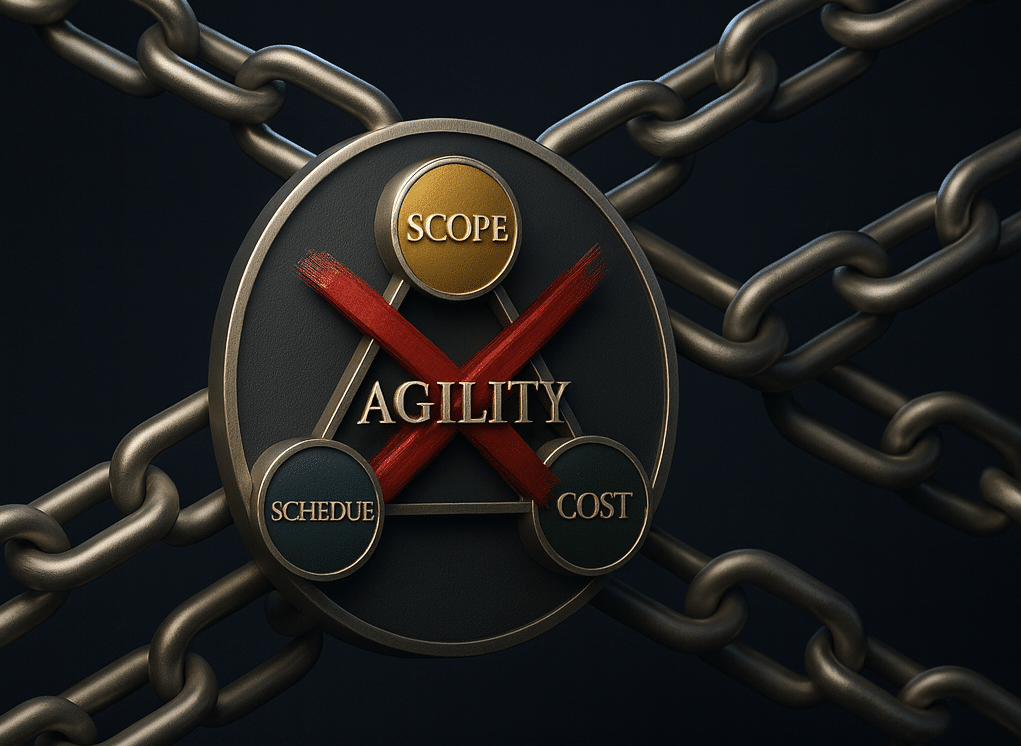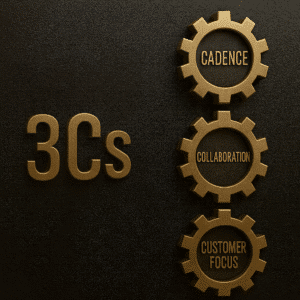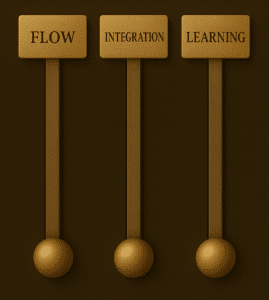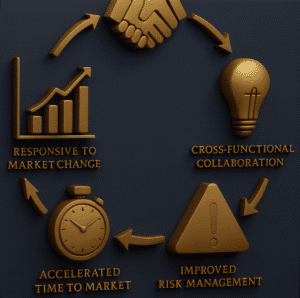Key Takeaways
- Agility is not only possible but essential for hardware development.
- The Iron Triangle is a trap that forces false choices, but it can be reframed to balance innovation and predictability.
- The 3Cs™—Cadence, Collaboration, and Customer Focus—provide the foundational principles for hardware agility.
- Flow, Integration, and Learning are the practical levers that turn these principles into responsive action.
- Real transformation requires a cultural shift, where leaders empower teams, focus on outcomes, and break down silos.
- You can start small, start now, and confidently scale your agile journey.
Hardware doesn’t have to be the last to change. By reimagining how we deliver products, we can break free from outdated constraints and accelerate innovation for the future.
Imagine standing at a crossroads. On one side is innovation—bold ideas, creative designs, and the chance to lead markets. On the other side is predictability—rigid schedules, controlled budgets, and the certainty of delivery. For decades, hardware leaders have been told they must choose one or the other.
Push too hard on innovation, and deadlines slip, costs balloon, and scope spirals. Clamp down on predictability, and creativity suffocates, opportunities vanish, and customers disengage. This false choice is the Iron Triangle—and it has trapped hardware organizations for far too long.
But what if the choice itself is the problem? What if innovation and predictability are not opposites, but partners?
It’s time to challenge the assumption that hardware must always be slow, costly, and locked into rigid plans.
In the following sections, we will explore why agility is not just possible, but essential for hardware, offering a new path where innovation thrives and predictability is genuinely achievable. You’ll discover the foundational principles of Cadence, Collaboration, and Customer Focus (the 3Cs™), and learn practical levers for implementing flow, integration, and continuous learning.
We’ll also examine the critical cultural shifts required for leaders to empower teams, focus on outcomes, and break down silos, ultimately enabling smarter delivery and products that truly meet customer needs.
The Trap of the Iron Triangle in Hardware

The Iron Triangle—scope, cost, schedule—has long been treated as the hard to bend reality of delivery. In hardware, that rigidity can become a trap. Leaders cling to it for predictability, but in reality, this rigidity creates bottlenecks and prevents innovation. Design cycles often stretch across years, requiring extensive simulation, modeling, and verification before a customer ever sees a prototype. Meanwhile, markets shift in months, technologies evolve faster than expected, and competitors introduce new features at a pace that traditional approaches struggle to match.
The result is a dangerous lag:
When teams are boxed in by inflexible scope and timelines, learning slows down. Instead of fostering creativity, the system penalizes it. In today’s fast-moving markets, that’s no longer sustainable.
- Months of carefully sequenced work may no longer reflect customer needs by the time a product finally ships.
- Competitors appear more agile, market windows close, and the trust once earned through reliability begins to weaken.
What was intended as control becomes fragility—an anchor that slows progress when speed and adaptability are required most.
Beyond the Binary: Agility as a New Path
The real challenge goes deeper than process. It’s about mindset. Leaders often assume that trade-offs are unavoidable—if you want to innovate, predictability will suffer; if you want predictability, innovation must be constrained. This binary view keeps organizations locked in the Iron Triangle.
Agility offers another path. It rejects the idea that innovation and predictability must compete. Instead, it encourages balance: shorter feedback loops, earlier integration points, and the courage to learn fast within constraints.
With agility, organizations don’t give up control—they shift from controlling outputs to guiding outcomes, from rigid trade-offs to adaptive choices that strengthen both innovation and delivery.
The 3Cs™: Principles for Hardware Agility
At the heart of this balance are three simple but powerful principles—the 3Cs™:

- Cadence creates rhythm. By aligning teams around a steady drumbeat of planning, execution, and review, chaos is replaced with confidence. Even in hardware, where parts are physical and timelines are real, cadence helps synchronize models, prototypes, and integration points.
- Collaboration breaks barriers. Hardware programs often fracture into silos—mechanical here, firmware there, software somewhere else. When disciplines co-create instead of handing off, they stop building parts and start building systems.
- Customer Focus provides direction. Hardware isn’t successful because it’s elegant—it’s successful because it solves the right problem. Prototypes, digital twins, and fast feedback loops ensure that innovation is aligned with what customers actually need.
Together, the 3Cs™ shift the conversation from either/or to both/and. Innovation and predictability. Speed and stability.
From Rigidity to Responsiveness—How to Break Free
Breaking free from the Iron Triangle doesn’t mean sacrificing predictability. In fact, agility allows hardware teams to balance innovation with reliability.
By focusing on three key levers—Flow, Integration, and Learning—hardware organizations can deliver faster, adapt more easily, and reduce risk along the way.
Three Levers That Turn Agile for Hardware Principles into Practice

1. Flow in Hardware Development
Instead of waiting months for a grand reveal, flow breaks big efforts into smaller, testable increments. Modular architectures, simulation-first development, and incremental builds allow progress to be measured, risks to surface earlier, and teams to move with greater predictability.
Flow isn’t just for software. Hardware teams can accelerate delivery by breaking large initiatives into smaller, testable increments. Using modular design, simulation, and parallel work, teams can keep value moving continuously instead of waiting months (or years) for results.
2. Integration: Building Systems, Not Silos
In hardware, integration is often where projects stumble. By designing for integration from the start—whether through modular design, cross-discipline planning, or synchronized testing—teams reduce late surprises and accelerate delivery.
Traditional hardware programs often isolate engineering disciplines—mechanical, electrical, firmware, and manufacturing. This separation causes delays and mismatches. By shifting toward integrated system thinking, teams reduce rework and discover issues earlier.
Collaboration across domains creates a holistic product, not just a collection of parts.
3. Learning Fast With Physical Constraints
Yes, building physical things takes time and money—but learning doesn’t have to. Prototyping, digital twins, rapid testing, and simulation allow teams to test assumptions before committing to costly production. The faster teams can validate ideas, the more likely they are to deliver products that customers truly value.
The Cultural Shift: Leadership and Mindset

The biggest lever isn’t technical—it’s cultural. Agility in hardware demands a mindset shift from leaders. Instead of controlling every detail, leaders empower teams, foster collaboration, and embrace learning as an asset rather than a risk.
The most profound change happens when leaders stop trading innovation against predictability and start enabling both. When leadership embraces this shift, teams unlock not just faster delivery, but smarter delivery—products that meet customer needs and arrive at the right time.
- Instead of commanding, they empower.
- Instead of obsessing over fixed dates, they focus on outcomes.
- Instead of protecting silos, they nurture system-level collaboration.
This shift in leadership creates the conditions for responsiveness. Without it, even the best processes will fall short.
What You Can Do Tomorrow
You don’t need a massive overhaul to begin. Start small. Here are three steps you can take immediately:
- Empower teams to own outcomes and make decisions closer to the work.
- Encourage cross-functional collaboration to break down silos.
- Prioritize learning through incremental prototypes and rapid feedback loops.
- Set a regular cadence for planning and review.
Each step builds momentum. Each experiment chips away at the rigidity of the triangle. Over time, innovation and predictability stop competing and start reinforcing one another.
Redefining Control in Hardware: How Agility Breaks the Cycle

Breaking the Iron Triangle doesn’t mean breaking the product. It means building a new path—one where innovation thrives, predictability is possible, and customers are at the center of everything.
Ready to get started? Download this actionable 3Cs™checklist that can help you with the 3Cs™ and unlock your organization’s potential to accelerate delivery.



